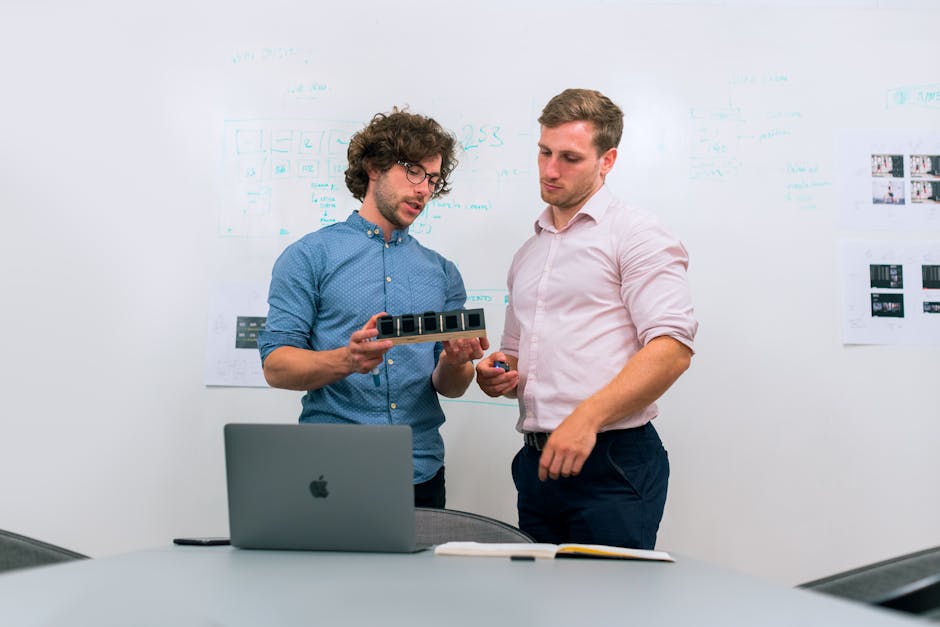Understanding The Use And Appeal Of ‘Prototype MVPs’
Did you know that 90% of start-ups fail within their first year? This staggering statistic highlights the need for businesses to find effective ways to validate their ideas and minimise risks.
One method that has gained popularity in recent years is the use of Prototype Minimum Viable Products (MVPs). These prototypes serve as a tangible representation of a product idea, allowing businesses to test its feasibility and gather valuable user feedback before investing significant resources into development.
In this article, we will delve into the world of Prototype MVPs, exploring their definition, purpose, and benefits. We will also discuss the key challenges in implementing them and provide strategies for creating effective Prototype MVPs.
By understanding the use and appeal of Prototype MVPs, you can leverage them to improve your chances of successful product development while minimising costly failures.
Key Takeaways
- Prototype MVPs are valuable tools for testing feasibility, gathering user feedback, and iterating on product ideas.
- User-centred design is crucial for creating successful products and prototype MVPs facilitate early user engagement and feedback.
- Gathering and analysing user feedback through surveys, interviews, and useability testing helps identify strengths and weaknesses of the prototype MVP and informs decision-making for improvements.
- Leveraging prototype MVPs is essential for validating assumptions about market demand, user preferences, and feasibility, and for successful product development.
The Definition and Purpose of Prototype MVPs

Prototype MVPs are created to test the feasibility and desirability of a product idea, allowing entrepreneurs to gather valuable feedback and make informed decisions about their future development. The importance of user-centred design cannot be overstated when it comes to creating successful products. By putting the user at the centre of the design process, entrepreneurs can ensure that their products meet the needs and desires of their target audience.
The role of prototyping in product development is crucial. Prototypes serve as a tangible representation of an entrepreneur’s vision, helping them communicate their ideas more effectively to stakeholders and potential users. They also allow for iterative design, enabling entrepreneurs to refine and improve their product based on real-world feedback.
One key benefit of using prototype MVPs is that they provide a low-risk way for entrepreneurs to test their ideas before investing significant time and resources into full-scale production. By creating a simplified version of their product, entrepreneurs can gauge its appeal in the market without committing too many resources upfront.
Another benefit is that prototype MVPs facilitate early user engagement. By involving users in the testing process from an early stage, entrepreneurs can gain valuable insights into user preferences, pain points, and suggestions for improvement. This feedback allows them to make necessary adjustments before launching a final version of their product.
Prototype MVPs play a vital role in product development by allowing entrepreneurs to test the feasibility and desirability of their ideas through user-centred design principles. The benefits include risk mitigation through low-cost testing and early user engagement. These advantages set the stage for discussing further benefits in terms of improving efficiency and reducing development costs in subsequent sections about ‘the benefits of using prototype MVPs.’
The Benefits of Using Prototype MVPs

Discover the incredible advantages of using early mock-ups that capture the essence of your vision, allowing you to vividly envision the future success of your product. Prototype Minimum Viable Products (MVPs) offer numerous benefits in the product development process. By creating a prototype MVP, you can gather valuable feedback from potential users and stakeholders at an early stage, enabling you to refine and improve your product before investing significant time and resources into development.
To better understand these advantages, let’s explore a 3×3 table showcasing real-life case studies and success stories:
| Advantages | Limitations | Case Studies/Success Stories |
|---|---|---|
| Enables early user feedback | May lack complete functionality | Uber’s initial app allowed them to test their concept with drivers and riders before scaling up |
| Saves time and money | Limited scalability for large-scale projects | Dropbox used a video demonstrating their concept to attract investors before building the actual product |
| Reduces risk by identifying flaws early on | Potential misinterpretation of design intentions | Airbnb created realistic photoshopped images as prototypes to gain traction amongst hosts |
As demonstrated in these case studies, prototype MVPs provide immense value by allowing companies to validate their ideas, attract investors or stakeholders, and minimise risks. Moreover, they enable iterative development based on user feedback, ensuring that the final product meets customer needs effectively.
Transitioning into the next section about key challenges in implementing prototype MVPs requires us to acknowledge that while there are undeniable advantages to using this approach, it is not without its difficulties.
Key Challenges in Implementing Prototype MVPs

Implementing prototype MVPs can present a set of unique challenges that must be overcome in order to fully harness their potential for success.
One key challenge is overcoming the limitations that arise during the prototyping stage. Since prototypes are simplified versions of the final product, they may not always accurately represent its full functionalities or capabilities. This can lead to misunderstandings or false expectations amongst stakeholders and users. To address this challenge, it’s crucial to communicate clearly with all parties involved, explaining the purpose and limitations of the prototype upfront.
Another challenge lies in managing expectations throughout the prototyping process. Stakeholders often have high hopes for what a prototype can achieve, expecting it to be flawless and fully functional from the start. However, prototypes are meant to evolve and improve based on user feedback and testing. It’s important to set realistic expectations about what can be achieved during each iteration of prototyping and emphasise that it’s an iterative process.
To overcome these challenges, effective strategies need to be implemented when creating prototype MVPs. By involving stakeholders early on in the development process, their concerns and expectations can be addressed proactively. Additionally, incorporating user feedback throughout each iteration ensures that prototypes aline better with user needs and desires.
Implementing prototype MVPs requires overcoming limitations associated with simplification while managing stakeholder expectations effectively. By employing strategies such as clear communication, involvement of stakeholders, and continuous user feedback integration, these challenges can be mitigated successfully. Transitioning into strategies for creating effective prototype MVPs involves understanding how different techniques contribute to achieving desired outcomes without compromising quality or efficiency.
Strategies for Creating Effective Prototype MVPs

To maximise the potential for success, it’s essential to employ effective strategies when developing prototype MVPs. These strategies ensure that the prototypes aline with user needs and expectations while minimising limitations associated with simplification. By following these strategies, you can create prototype MVPs that effectively capture the essence of your product or service while still being able to iterate and improve upon it.
Strategies for Creating Effective Prototype MVPs:
-
Start with a clear vision: Before diving into the development process, define your vision for the product and its core value proposition. This will guide all subsequent decisions and help maintain focus on what truly matters.
-
Identify key features: Determine the most critical features that need to be included in the minimum viable product (MVP). These should be based on user research, market analysis, and an understanding of what sets your product apart from competitors.
-
User-centred design: Prioritise features that address specific pain points or meet user needs. Keep in mind that simplicity is key during this stage.
-
Iterative design: Embrace an iterative approach by constantly testing and refining your prototype based on user feedback. This allows you to validate assumptions and make necessary adjustments early on.
- Focus on useability: While simplicity is important, ensure that your prototype is easy to use and understand. Conduct useability tests throughout the development process to identify any pain points or areas where improvements can be made.
By implementing these strategies, you can develop a prototype MVP that effectively communicates your product’s value proposition while remaining open to iteration based on user feedback. In the next section about ‘gathering and analysing user feedback,’ we’ll explore how this valuable information can inform further improvements in your prototype MVP.
Gathering and Analysing User Feedback

Engage in the process of collecting and comprehending user feedback to gain valuable insights that can guide the growth and improvement of your prototype MVP. User engagement is crucial at this stage as it allows you to gather firsthand information about how users interact with your product and what improvements they suggest. By actively involving users in the feedback process, you can ensure that their needs and preferences are taken into account during iterative improvement.
To effectively gather user feedback, consider using different methods such as surveys, interviews, or useability testing. Surveys allow you to collect quantitative data on user satisfaction and preferences, while interviews provide more qualitative insights by allowing users to share their thoughts and experiences in-depth. Useability testing involves observing users as they interact with your prototype MVP, providing valuable insights into areas that may require improvement.
Once you have collected user feedback, it is important to analyse it thoroughly. Look for patterns or common themes in the responses to identify areas where your prototype MVP excels and areas where it falls short. Pay attention not only to what users say but also to their actions during useability testing. This will help you prioritise changes that will have the greatest impact on user experience.
Incorporating a table can add a level of sophistication to your analysis by visually presenting key findings from user feedback. Consider including columns for specific features or aspects of your prototype MVP and rows for different user responses or suggestions. This format allows for easy comparison and identification of trends.
By gathering and analysing user feedback effectively, you can make informed decisions regarding the improvements needed for your prototype MVP. These insights will guide you towards leveraging prototype MVPS for successful product development without missing any crucial steps in the process . Ultimately, this will help you stay ahead of market trends and customer demands, ensuring that your final product alines with the current industry landscape and meets the needs of your target audience.
Leveraging Prototype MVPs for Successful Product Development

Make the most of your prototype MVPs by leveraging them for successful product development and achieving your goals. Prototype MVPs serve as invaluable tools in the product development process, allowing you to gather user feedback and iterate on your ideas before investing significant time and resources into a full-scale product.
Here are four key ways to leverage prototype MVPs effectively:
-
Emphasise a user-centric approach: When developing a prototype MVP, it’s crucial to prioritise the needs and preferences of your target users. By incorporating their feedback early on in the process, you can ensure that your final product meets their expectations and solves their pain points effectively.
-
Conduct thorough case studies: Examining successful implementations of prototype MVPs from other companies can provide valuable insights and inspiration for your own product development journey. Analyse how these companies identified their target market, designed prototypes that resonated with users, and iterated based on feedback to achieve success.
-
Iterate quickly based on user feedback: Prototype MVPs allow you to collect real-time data from users, enabling you to identify areas for improvement swiftly. Continuously iterating on your prototypes based on this feedback ensures that your final product will be better alined with user needs.
-
Validate assumptions before investing heavily: By using prototype MVPs as experimental testing grounds, you can validate or invalidate assumptions about market demand, user preferences, or technological feasibility without committing significant resources upfront.
Leveraging prototype MVPs effectively is essential for successful product development. Taking a user-centric approach while analysing case studies of successful implementations can provide valuable insights. Additionally, iterating quickly based on user feedback helps refine prototypes and validate assumptions before making substantial investments in production-ready products.
Frequently Asked Questions
How can I effectively prioritise features and functionalities in a prototype MVP?
To effectively prioritise features and functionalities in a prototype MVP, start by identifying the key features that aline with your project goals. Consider user feedback, market demand, and potential impact on the overall user experience.
What are some common mistakes to avoid when creating a prototype MVP?
When creating a prototype MVP, common mistakes to avoid include: not focussing on the core problem, overcomplicating the design, neglecting user feedback, and failing to prioritise features strategically. Best practises involve iterative testing and continuous improvement.
How can I ensure that user feedback is accurate and representative of the target market?
To ensure accurate and representative user feedback, consider the following: clearly define your target market, recruit participants who fit this profile, ask specific questions, conduct useability tests, and analyse the data collected to gain valuable insights.
Are there any industry-specific considerations when implementing prototype MVPs?
When implementing prototype MVPs, you need to consider industry-specific challenges and choose appropriate implementation strategies. These considerations will ensure that your prototypes effectively address the unique needs of your target market.
Can prototype MVPs be used for both physical and digital products, or are they more suitable for one over the other?
Prototype MVPs can be used for both physical and digital products. However, there are pros and cons to consider in each case. In physical product development, prototype MVPs allow for hands-on testing, while in digital product development, they enable rapid iterations and user feedback.
Conclusion
In conclusion, understanding the use and appeal of ‘prototype MVPs’ is crucial for successful product development. By creating these preliminary versions, you can gather valuable user feedback and make necessary improvements before investing significant resources.
Despite the challenges involved in implementing prototype MVPs, such as limited functionality or potential technical issues, they offer numerous benefits like reducing time-to-market and minimising risks.
Just like a rough diamond that undergoes polishing to reveal its true brilliance, prototype MVPs allow you to refine your product until it shines with perfection.
Contact us to discuss our services now!
